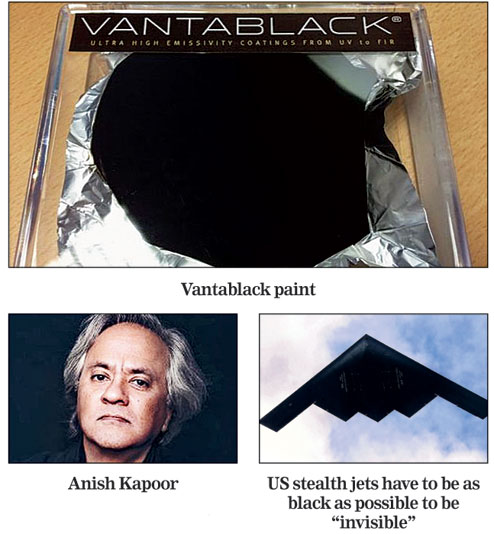
London, Feb. 28: The artistic fraternity today rounded angrily on Sir Anish Kapoor after it was reported that the renowned Indian-origin sculptor had established monopoly rights over the blackest paint in the world called "Vantablack" - meaning no other artist can use the product.
The paint, which is made by a UK firm, Surrey NanoSystems, is said to be so black that it "absorbs a maximum of 99.965 per cent of radiation in the visible spectrum".
This makes it especially suitable for military applications such as on US stealth jets which seek to remain hidden from enemies.
The manufacturers of the paint have apparently struck a deal with the 61-year-old Mumbai-born artist, who is known to be a multi-millionaire. He co-designed the £16-million ArcelorMittal Orbit for the Olympic Park in London in 2012, though that uses red paint.
An English artist, Christian Furr, protested: "We should be able to use it - it isn't right that it belongs to one man."
Shanti Panchal, an Indian-origin artist in London who uses layer upon layer of water colours to create the darkest hues, told The Telegraph: "I have not known of anything so absurd - in the creative world, artists, nobody should have a monopoly."
To say something has the colour black is, strictly speaking, a contradiction in terms, scientists say. Something is black because it absorbs all light in the visible spectrum falling on it, as is taught to every physics student in the world.
The Cambridge astrophysicist Stephen Hawking would also note that "black holes" get their name because their incredibly high density and gravitational pull prevent even light from escaping them.
People are able to see something is black precisely because it is not - some of the light falling on an object is reflected back and seen by the human eye.
Speaking to Sarah Montague on the BBC Radio 4's Today programme, Kapoor did not discuss his monopoly over the paint but enthused about the distinctive properties of Vantablack: "It's effectively like a paint... it's so black you almost can't see it. It has a kind of unreal quality and I've always been drawn to rather exotic materials because of what they make you feel."
In his early days, he had used Indian pigments such as bright saffron and other earth colours although he has always resisted being pigeon-holed as "ethnic".
He continued lyrically: "Imagine a space that's so dark that as you walk in, you lose all sense of who you are and what you are, and also all sense of time. Something happens to your emotional self and in disorientation one has to reach in for other resources."
Vantablack is considered "the blackest black in the world and highly desired by artists", the Mail on Sunday reported.
The paper said: "Most of us might consider that the colour black is, well, simply black. But not great artists. To them, the subject is far more nuanced. And there's one shade they all want to get their hands on - the blackest black in the world. That title is currently held by a paint called Vantablack."
"And now the world-famous sculptor Sir Anish Kapoor... has been given exclusive rights to use the colour - sparking a furious reaction from other artists," according to the Mail.
Kapoor is no stranger to controversies. Last year, for example, he caused a big fuss with an installation at the Palace of Versailles provocatively called Dirty Corner, an enormous trumpet-like structure said to resemble the vagina (which figures repeatedly in his artistic work).
Christian Furr, the youngest artist ever commissioned to paint the Queen, told the Mail: "All the best artists have had a thing for pure black - Turner, Manet, Goya. This black is like dynamite in the art world."
Furr, who had planned to use Vantablack in a series of paintings called Animals, made the same point as Panchal: "I've never heard of an artist monopolising a material. Using pure black in an artwork grounds it."
Vantablack "absorbs so much light that the human eye cannot pick up the kind of shadows which help the brain to interpret the shape of an object. Remarkably, a crumpled piece of tin foil covered with a layer of the paint appears almost completely flat".
Kapoor has used other types of black paint in the past to stunning effect - including in a body of work called Descent Into Limbo, in which a circle painted on to the floor creates the illusion of a gaping hole.
Visitors to the Science Museum in London can currently see Vantablack in a work that will be on display until June. It features a bust which, to the naked eye, appears to be flat rather than three-dimensional "because it is covered in the extraordinary paint", the Mail said.
From his home in Italy, Russell Elliott, who represents many artists in Britain and elsewhere in Europe, said: "Rather like Christian Furr, I haven't heard of any artist who has previously been granted a monopoly on a particular colour before, and it does seem to set an unfortunate precedent. Previously, companies have stipulated the pantone reference in their logo guidelines and this has become standard practice."
Elliott said he did not wish to be cynical but "NanoSystems must be pleased with their press coverage".
He could think of one exception to the rule: "I forgot about International Klein Blue, a colour patented in France on 19 May, 1960, by Yves Klein, an ultramarine blue - apparently only valid under French law."
The manufacturers say that Vantablack is a substance made from carbon nanotubes - it is composed of a forest of vertical tubes which are "grown". When light strikes Vantablack, instead of bouncing off, it becomes trapped and is continually deflected between the tubes before eventually becoming heat.
This substance has many potential applications, including preventing stray light from entering telescopes, and improving the performance of infrared cameras both on earth and in space.
Ben Jensen, chief technology officer of Surrey NanoSystems, said: "For example, it reduces stray-light, improving the ability of sensitive telescopes to see the faintest stars... it's ultra-low reflectance improves the sensitivity of terrestrial, space and air-borne instrumentation. Vantablack may also increase the absorption of heat in materials used in concentrated solar power technology, as well as military applications such as thermal camouflage."











